BSCI 170 - The Regulation of Prokaryotic Gene Expression
1/40
There's no tags or description
Looks like no tags are added yet.
Name | Mastery | Learn | Test | Matching | Spaced |
|---|
No study sessions yet.
41 Terms
Prokaryotic Genes
What are genes that are always actively expressed?
Why may some genes be on or off?
How do the expression of genes meet metabolic needs?
constitutive expression; e.g. genes for glycolytic enzymes
depending on environmental conditions
they are very variable and highly coordinated
Bacterial Gene Expression
What kind of pressure are bacteria under to survive?
What does this lead to?
Bacteria are under extreme competitive pressure to survive
small selective advantages are the difference between life and death
What can gut-living bacteria do?
make whatever they need
if they can get nutrients from environment, then no reason to make them from scratch
save energy for reproduction, etc.
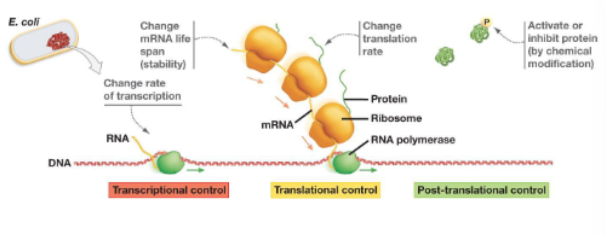
Levels of Gene Control
What is “gene expression” related to?
the amount of functional product in a cell
All 3 Levels Are Active in Cells
What are characteristic of translational and posttranslational controls?
What is characteristic of transcriptional control?
rapid, but energetically costly; all resources already generated
slower, but more energetically efficient
Prokaryotic Gene Organization
In E. coli, how is amino acid tryptophan synthesized?
in a multi-step process
each step is catalyzed by a different enzyme coded for by one or more of 5 genes
All 5 genes are clustered on the chromosome in the order they are used
What are the gene clusters clustered on the chromosome in the order they are used called?
operons
What does one promoter do?
coordinately regulate the transcription of all 5 genes
Operon Control
Is the operon on/off control switch the promoter?
What does the operator overlap? What does it lie between?
no; the switch is a short DNA sequence called the operator
the promoter; it lies between the promoter and the transcription start site
How does the operator control accress to the promoter?
by RNA polymerase
What comprises the operon?
the promoter, the operator, and the transcription unit
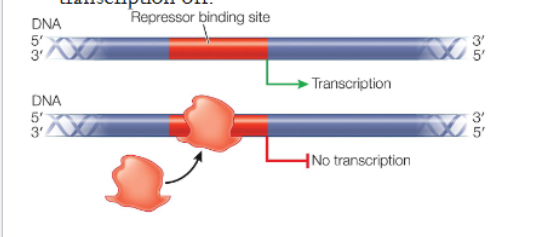
What are the two general operon types?
negatively regulated: the genes are normally on, and binding of a repressor protein to the DNA turns transcription off
positively regulated: the genes are normally off, and binding of an activator protein to the DNA turns transcription on
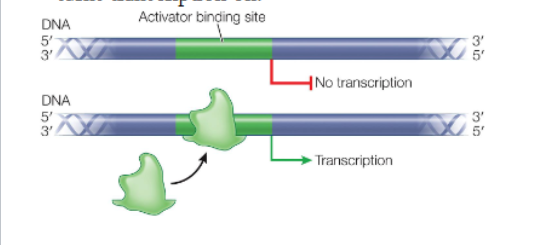
What is an example of negative control?
the repressible operon
What is the repressible operon?
a repressible operon is normally active but is turned off when a specific repressor protein binds to the operator
the repressor blocks access by RNA polymerase to the promoter or to the genes
What is the trp operon?
it is normally active
RNA polymerase has access to the promoter
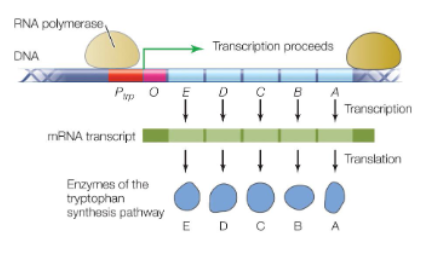
What is the trp Repressor?
the product of a gene (trpR) located outside and upstream of the operon
What is characteristic of the trpR gene?
it is constitutively active at a low level; there is always some repressor protein available
If the repressor is always available, then why isn’t the operon turned off all the time?
binding to operator is reversible
the repressor is an allosteric protein
What are the two conformations that allosteric proteins exist in? Designate these as functional or nonfunctional.
active conformation: functional
inactive conformation: nonfunctional
What does binding a regulator do? What are the types of regulators; what do they do?
stabilize the protein in one state or the other
activator: stabilizes in active conformation
inhibitor: stabilizes in inactive conformation
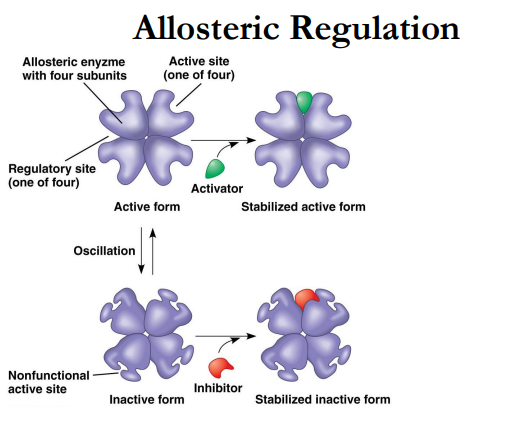
Action of the trp Repressor
What kind of protein is the trp repressor?
What is it mostly present as?
What is tryptophan?
an allosteric protein
in the inactive form
an active allosteric effector (corepressor)
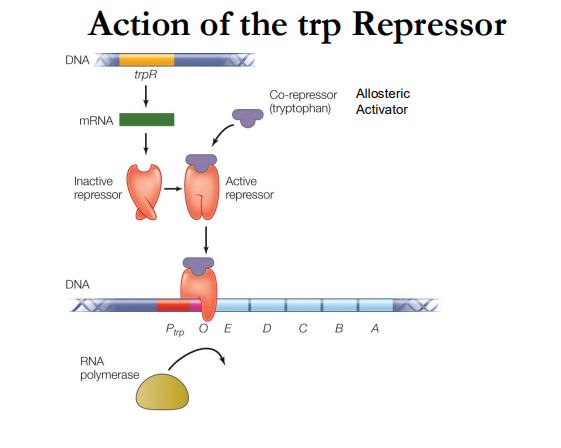
Summary:
What state is the trp operon in normally?
What does the expression of the operon lead to?
What occurs when tryptophan is present in the environment?
the trp operon is normally active
expression of the operon leads to production of enzymes for making tryptophan (tryptophan is necessary to make protein)
if tryptophan present in the environment:
tryptophan binds to the repressor
trp-repressor complex binds to operator
operon transcription repressed
Negative Control Example 2: The Inducible Operon
What state is an inducible operon normally in? Why?
How can an operon be turned on? Why?
What is a classic example of an inducible operon?
an inducible operon is normally off because of an active repressor
the operon can be turned on in the presence of an inducer; the inducer inactivates the repressor
classic example if the lactose operon
regulates metabolism of lactose
lactose is available to E. coli cells if host consumes milk or milk products
Metabolism of Lactose (Milk Sugar)
What is lactose a disaccharide of?
What is the first step of the metabolism of lactose?
Lactose is a disacchride of B-Glucose and B-Galactose
Step 1 is cleavage of the B-glycosidic bond
B-Galactosidase (B-Gal)
Metabolism of Lactose
Without lactose, only a few molecules of permease and B-Gal are present
With lactose, what happens to the amount of B-Gal?
The amount of B-Gal increases 1000X in 15 minutes
lac Operon
What is the lac operon comprised of?
What is the lac Regulatory gene? Where is it located?
What does it encode?
What is it essentially?
The lac operon comprises a promoter, an operator, and 3 genes
the lac Regulatory gene, lacI, is located upstream from the operon
encodes an allosteric protein
lac Repressor
lac Repressor
What does the repressor bind to?
What does the repressor prevent?
How does the repressor bind?
The repressor binds to the operator
The repressor prevents RNA polymerase from binding to the promoter and moving forward; conceptually identical to trp repressor
Repressor binds operator without a corepressor
different from the trp repressor
What happens to some lactose in the cell when lactose is present?
some lactose in the cell is converted to an isomer of lactose (allolactose)
When lactose is present what does allolactose bind to? What does this cause? What does this make allolactose?
allolactose binds to and inactivates lac repressor; this makes allolactose an inducer
Summary
In the absence of lactose, where does the lac repressor bind?
When lactose is available, what happens to some of the lactose?
What does allolactose bind to?
How does the lac repressor shift in its conformation?
What occurs after this shift in conformation occurs?
lac repressor binds the operator and keep operon inactive
some of the lactose is converted to allolactose
allolactose binds to lac repressor
lac repressor shifts to inactive allosteric conformation and detaches from the operator
transcription of the operon commences
lac Operon vs. trp Operon
lac operon is _______ - what does this mean?
trp operon is ____________ - what does this mean?
inducible
repressor normally bound and then unbinds
inducer converts repressor to inactive form
operon transcribable
repressible
repressor normally unbound and then binds
corepressor converts repressor to active form
operon not transcribable
lac Operon vs. trp Operon
what do inducible operons generally function in? Why?
what do repressible operons generally function in? Why?
inducible operons generally function in catabolic pathways
you break things down only if they are present
repressible operons generally function in anabolic pathways
you build things up only when they are not available
Positive Control: Operon Regulation
How are both the lac and trp operons controlled?
What does it mean if an operon is negatively controlled?
What does it mean if an operon is positively controlled?
How can the lac operon be regulated?
both are negatively controlled
operon transcription is switched off in the presence of an active form of a repressor
operon transcription is switched on in the presence of an active form of an activator
the lac operson can be regulated both positively and negatively
Positive Gene Regulation
What do E. coli cells prefer to use as their energy source?
Why?
When will E. coli activate genes for lactose metabolism? What is this called?
E. coli cells prefer to use glucose as their energy source when it is available
glycolytic enzymes are always present, always active, and very efficient
E. coli will activate genes for lactose metabolism only when lactose is present AND glucose is absent (or low).
How does E. coli sense the presence of glucose?
a regulatory protein interacts with a small signaling molecule
regulatory protein is catabolite activate protein (CAP)
signaling molecule is cyclic AMP (cAMP)
[cAMP] in cell is inversely related to [Glucose] outside the cell
High [Glucose]out correlates with low [cAMP]in
Positive Regulatory Protein
How is CAP regulated?
What does the active CAP-cAMP complex bind to?
CAP is regulated allosterically
cAMP binding to CAP stabilizes CAP in the active conformation
cAMP is allosteric activator
Active CAP-cAMP complex binds to DNA upstream of the lac promoter
presence increases efficientcy of RNA polymerase binding to the promoter
lac Promoter
Are all promoters equal?
Why?
What is polymerase binding related to?
How does the lac promoter bind RNA polymerase even in the absence of repressor?
all promoters are NOT equal
some bind polymerase efficiently
some bind polymerase inefficiently
polymerase binding is related to amount of transcription
the lac promoter binds RNA polymerase poorly even in the absence of repressor
Catabolite Repression
When CAP is inactive, what occurs to RNA polymerase?
RNA polymerase binding is weak and transcription activity is low
Dual Control of the lac Operon
When lactose is present and glucose is also present, what is the state of the operon?
When lactose is present and glucose is absent, what is the state of the operon?
the operon is weakly active
the operon is highly active
Dual Control of the lac Operon
_________ control by the lac repressor
What does the state of the lac represoor determine?
What does an active repressor do?
What does an inactive repressor do?
What is a repressor like?
negative
whether the operon is transcribed
turns gene transcription “OFF”
turns gene transcription “ON”
an on/off switch
Dual Control of the lac Operon
_________ control by CAP
What does the state of CAP determine?
What does an “inactive” activator do?
What does an “active” activator do?
What is CAP like?
Many way to fine tune gene expression
Positive
the level of transcription
turns level of gene transcription “DOWN”
turns level of gene transcription “UP”
a volume control